Understanding Link Quality and Website Metrics
Search engine optimization (SEO) plays a crucial role in any marketing strategy, with link quality being a significant determinant of SEO success. To achieve favorable organic rankings, it’s crucial to grasp effective methods for evaluating link quality.
Experts rely on various website metrics like Domain Authority (DA), Page Authority (PA), Trust Flow (TF), and Citation Flow (CF) to understand link quality. These website metrics aid in assessing the worthiness of a potential link and determining the resources needed for its acquisition.
Understanding these website metrics is beneficial for conducting comprehensive link profile analyses, whether for your own website or that of a competitor.
While measuring the impact of link building can be challenging, familiarity with these elements facilitates the process. Today, we will learn why link quality matters more than quantity, the factors that affect link quality, and key link quality metrics.
Importance of Link Quality over Link Quantity
Imagine you’re applying for a job and:
Scenario 1: Link Quantity (Low Quality)
You have 100 recommendations, but:
- They are all from friends and family.
- None are from relevant industry professionals.
- The recommendations are generic and don’t highlight your skills.
Scenario 2: Link Quality (High Quality)
You have 5 recommendations, but:
- They are well-respected professionals in your field.
- The recommendations speak directly to your skills and experience.
- The recommenders are known by the hiring manager.
In SEO, links are like recommendations for your website. Just like in the job application example, having a high number of low-quality links won’t help you rank higher in search results. In fact, it can even hurt your ranking. Search engines like Google value links from relevant, authoritative websites. These links signal that your website is trustworthy and has valuable content.
Factors to Improve Backlink Quality
Anchor Text

Anchor text refers to the text containing a hyperlink on a webpage. The text containing your link (anchor text) should be relevant to your content. Descriptive anchor text tells search engines what your page is about, improving its ranking potential.
For instance, a link leading to a page about “organic gardening ” should incorporate the keywords “affordable organic gardening practices”.
Using relevant keywords in your anchor text is an SEO practice one should adopt for anchor text optimization. It helps search engines improve the user experience by clearly indicating what the link leads to.
Spammy Links

Google penalizes websites that accumulate a significant quantity of “spammy” links. A “spammy” link typically originates from a low-quality website or one that primarily exists to host numerous links.
Acquiring links through unethical methods such as purchasing them or employing black hat SEO tactics often results in an abundance of low-quality links, which adversely affects a website’s backlink profile. So it’s always advisable to disavow spammy links.
In this case, Google Search Console offers a tool. However, it’s recommended to consult an SEO professional for guidance before proceeding.
Here’s a general overview of the disavow process through Google Search Console:
- Identify spammy links: Use SEO tools or manual checks to find low-quality backlinks.
- Create a disavow file: This is a text file listing URLs or entire domains you want Google to disregard.
- Follow proper formatting: Specific guidelines exist for formatting the disavow file. Errors can prevent successful disavowal.
- Upload to Search Console: Access the Disavow Links tool in Search Console and upload your prepared disavow file.
It’s important to note that disavowing links takes time to take effect. It can take weeks for Google to recrawl and update your website’s ranking.
Location of a Link
The location of your link on a page can influence its value. Links within the main content are generally more valuable than those in sidebars or footers.
While any backlink can be helpful, prioritize placements within a website’s main content for maximum SEO impact. This can be achieved through guest blogging, broken link building, creating link-worthy content, or strategic outreach.
The duration required to obtain new links
When employing white hat SEO strategies, building a website’s backlink profile is a gradual process. There is no advantage in rapidly accumulating a vast number of links.
If you analyze competitor backlinks and observe a sudden increase in their acquisition of new links, it could indicate the potential use of black hat techniques to build their backlink profile.
So instead of worrying about the link acquisition speed, create valuable content that attracts natural backlinks. Target your content towards your ideal audience, establish yourself as an authority, and watch organic links grow over time.
Quality of content

Google’s ability to analyze content is evolving with increasing sophistication. Machine learning and AI technologies are streamlining the process for Google and other search engines to assess content quality.
The quality of content linked to or from which the link originates influences the value of the link. So in this case, always create informative and engaging content that others will want to link to, naturally boosting your backlink profile.
Relevance

Topical relevance is a crucial factor in backlink quality. Links from websites within your semantic niche (related topics and subtopics) carry more weight than those from completely unrelated domains. Google uses revolutionary algorithms to analyze topic coherence.
While there is no single metric, tools like Ahrefs or SEMrush can help identify websites with overlapping topical clusters, suggesting higher relevance for link building. Ultimately, your judgment is crucial. Look for websites that naturally discuss themes related to yours, ensuring a strong contextual fit for the link and a positive user experience.
First link vs. second link
The idea of “first link priority” is a complex topic in SEO, and its exact weight in backlink value is debated. In the past, search engines might have prioritized the first encountered text link on a page for passing link juice.
While some believe this still holds some weight, Google’s algorithm is likely more sophisticated now. It likely considers all links on a page and analyzes factors like context, anchor text relevance, and overall link profile of the linking website.
Aim for high-quality, relevant backlinks wherever they appear on a page. The first position might offer a slight benefit, but it’s not the sole focus.
Follow and No Follow
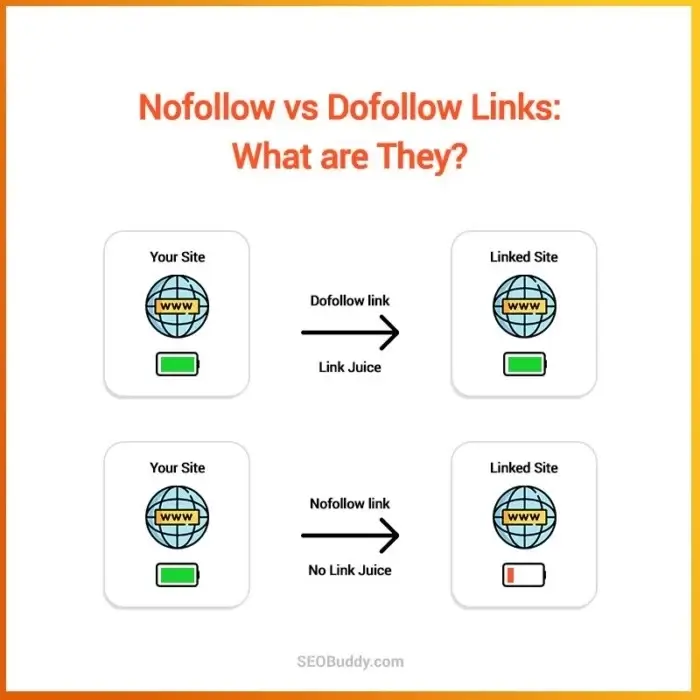
Follow links contain a rel=”follow” attribute within the HTML code. Search engines like Google crawl these links and consider them when determining your website’s ranking position.
Nofollow links contain a rel=”nofollow” attribute within the HTML code. Search engines are instructed not to follow these links for ranking purposes. While nofollow links don’t directly impact SEO ranking, they still offer significant benefits like referral traffic.
A healthy backlink profile consists of a mix of both follow and nofollow links. This creates a natural distribution that search engines view favorably. Focus on acquiring high-quality backlinks, regardless of the follow/nofollow status, from relevant websites in your niche.
Key Quality Metrics of Backlinks
Domain Rating (DR)

Domain Rating (DR) is a metric developed by Ahrefs that reflects the strength and credibility of a website based on its backlink profile. The more high-quality backlinks you have, the higher your DR will be. DR is measured on a scale of 0 to 100, with 100 indicating the strongest backlink profile.
How does DR work?
Link juice is a form of authority that flows from one website to another through backlinks. A website with a high DR has a lot of link juice to distribute among the websites it links to. The more selective a website is with its links (linking only to high-quality sites), the more potent its link juice becomes.
Here’s what to consider when calculating DR:
- Quantity and Quality of Backlinks: The number of backlinks you have is important, but the quality matters more. Backlinks from relevant, authoritative websites carry more weight than links from low-quality sites.
- Diversity of Linking Domains: DR takes into account the number of unique websites that link to you. Having backlinks from a variety of sources indicates a more natural and trustworthy backlink profile.
- Strength of Linking Domains: The DR of the websites linking to you also plays a role. Backlinks from high-DR websites contribute more value than those from low-DR sites.
- Selectivity of Linking Domains: Websites that are selective with their links (linking only to a few high-quality sites) pass on more link juice compared to those that link out frequently.
A good DR score depends on your industry, competition, and the age of your website. Generally, a DR above 50 is considered good, with scores in the 60-100 range being exceptional. A DR between 40-50 is decent, but there’s room for improvement. Scores below 40 indicate a weak backlink profile that could benefit from link-building efforts.
Domain Authority (DA)
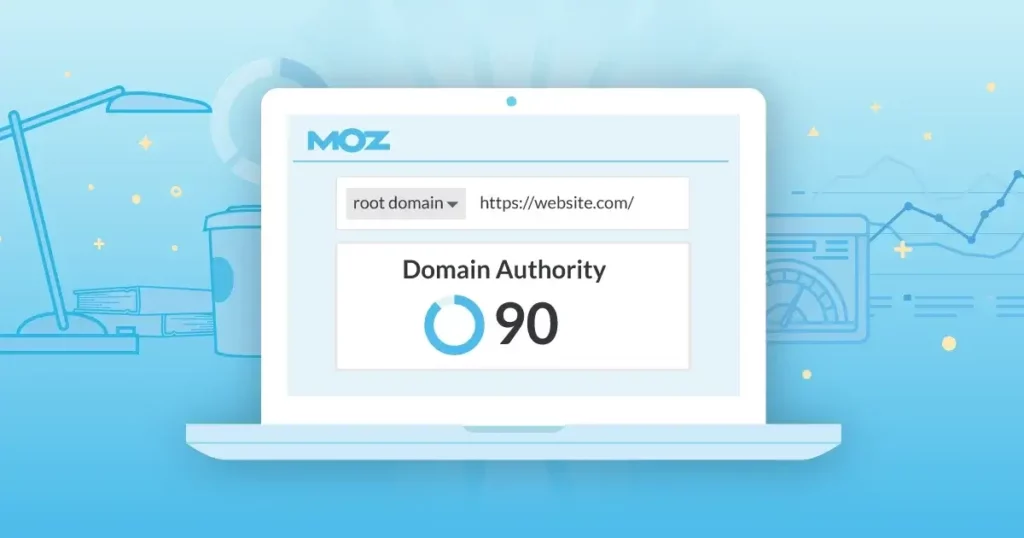
Domain Authority (DA) is a metric developed by Moz to predict a website’s ranking potential on Search Engine Results Pages (SERPs). It reflects a website’s strength and credibility, largely determined by the quantity and quality of backlinks pointing to it.
Websites with a higher DA are generally seen as more trustworthy and authoritative by search engines. For instance, a website with a DA of 60 is usually seen as more powerful than one with a DA of 30.
How Backlinks Affect DA?
Backlinks can be either do-follow or no-follow. Do-follow links pass on some of the “link juice” (authority) from the source domain to your website, which helps boost your DA. No-follow links, while not directly impacting DA, can still drive traffic and improve brand awareness.
It’s important to remember that DA is not a direct ranking factor used by search engines like Google. However, it serves as a valuable indicator of your website’s overall SEO health. By focusing on building high-quality backlinks from relevant and authoritative websites, you can improve your DA, which can in turn, positively influence your search ranking potential.
Page Authority (PA)

Page Authority (PA) tells you how strong and good a webpage is. It looks at things like how many other websites link to that page, and how good those websites are. Pages with high PA usually show up higher in search results and get more people visiting them from search engines.
For example, if a popular blog post with good and relevant links points to your webpage, it can make your PA better. To improve PA, you need to get good links from trustworthy websites and make sure your webpage has useful content that people like. Focusing on PA is important for making your webpage easier to find in searches and getting more people to visit it.
Trust Flow (TF)
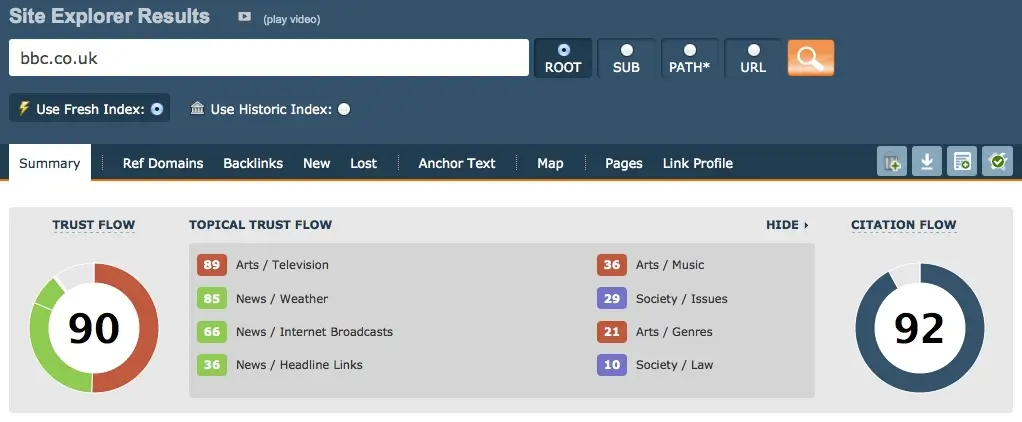
Trust Flow is a link metric used to assess a website’s trustworthiness and credibility. It analyzes the quality of backlinks pointing to a site, not just the quantity.
How is Trust Flow Calculated?
Score Range: 0-100 (higher score = higher trust)
Factors Considered:
- Number of trusted websites linking to a page
- Trust Flow values of linking domains
- Connection of linking domains to trustworthy sources
Websites with high Trust Flow tend to rank better in search results and attract more organic traffic due to their perceived reliability. To improve the Trust Flow, Build backlinks from high-authority and trustworthy websites relevant to your niche.
For example, a health website should aim for backlinks from medical journals and government health resources, not unrelated sources. A health website with backlinks from reputable medical journals will likely have a higher Trust Flow than one with backlinks from unrelated sources.
Citation Flow (CF)
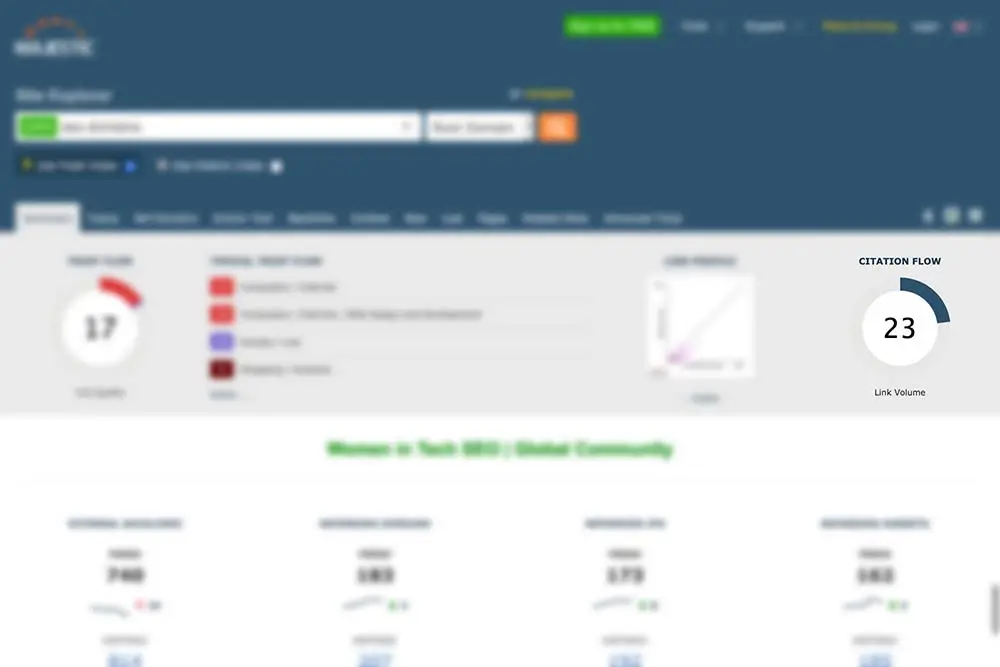
Citation Flow (CF) is part of Majestic’s Flow Metric algorithm, along with Trust Flow (TF), Topical Trust Flow, Visibility Flow, and Search Flow.
CF assesses the number of links to a website and predicts its potential influence. It’s unique to Majestic SEO and is graded from 0 to 100. For example, a high CF score suggests plentiful high-quality backlinks, while a medium score indicates a potential lack in either quality or quantity.
To improve a site’s CF, consider:
- Writing content relevant to keywords.
- Engaging reputable sources for link-building.
- Generating link-worthy assets such as infographics.
Anchor Text Distribution

Assessing backlinks involves considering the quality of anchor text. Anchor text is the clickable text in a link that tells search engines (and users) what the linked page is about. Good anchor text should be clear and relevant to the content it links to, using keywords that accurately describe the target page.
Let’s understand types of anchor text using examples:
- Exact Match Anchor: This is the most specific, using the exact keyword you want to rank for. For example, linking to a page about “SEO tips” with the anchor text “SEO tips”.
- Partial Match Anchor: This varies the keyword slightly, including surrounding words. Linking to that same “SEO tips” page with text like “learn valuable SEO tips” is a partial match.
- Branded Anchor: This uses your brand name or a variation in the anchor text. Linking to your homepage might use “Visit [Your Brand Name]”.
- Generic Anchor: This is a generic word or phrase that doesn’t tell much about the linked content. Examples include “click here” or “learn more”.
Here’s what to avoid:
- Generic phrases: Words like “click here” don’t tell search engines much.
- Keyword stuffing: Repeating the same exact keyword over and over can look suspicious.
Focus on natural-sounding anchor text that benefits both users and search engines. This will help your links be more valuable and avoid any potential issues.
Referring Domains (number of unique linking sites)
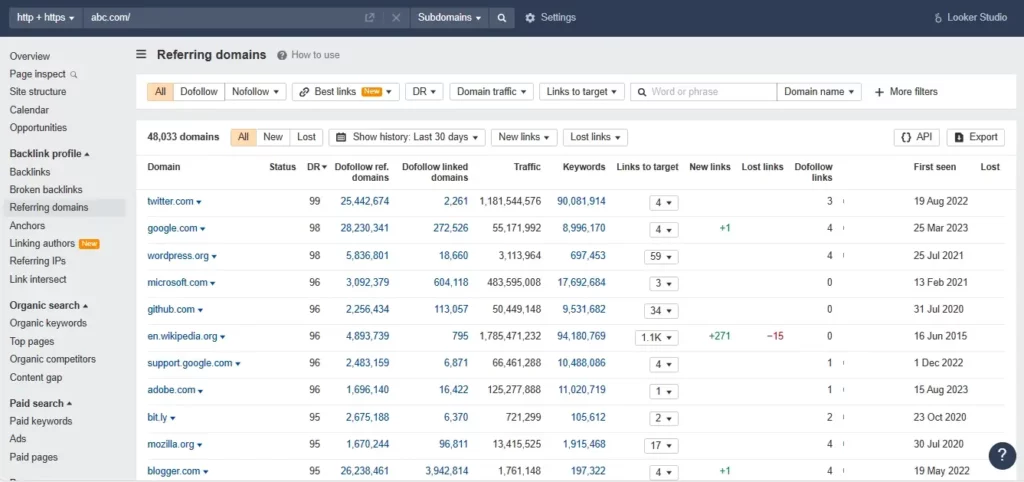
The count of referring domains is a crucial factor when assessing backlinks. It shows how many different websites link to yours. For example, having more referring domains usually signals greater trustworthiness and authority to search engines.
However, it’s not only about the number; the quality of these domains matters too. Sometimes, a website with only a few top-notch referring domains can rank higher than one with numerous low-quality ones.
It’s vital to diversify your backlink portfolio by gaining links from various relevant and authoritative domains. Doing so can improve your odds of achieving higher rankings in search engine results.
Blog Traffic Demographics
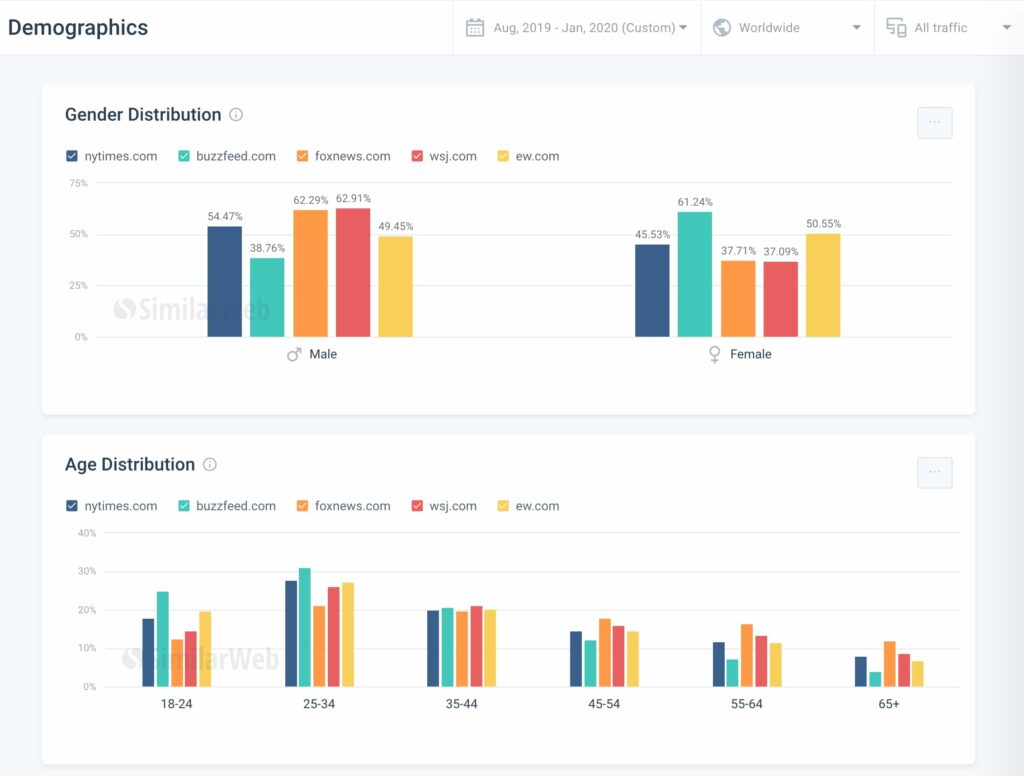
A large, national audience might seem impressive, but if it is not relevant to the location of your targeted audience, it offers little value. The ultimate goal behind every backlink is getting referral traffic, so a smaller, local audience with a high degree of relevance is much more likely to be interested in your content and convert it into customers or leads.
Blog traffic demographics can be a supportive metric for evaluating the quality of a backlink. They help you assess the audience’s location, interests, and online behavior. Here’s how you can strategically use traffic demographic metrics:
Identify the Geographic Location of Visitors
Assess if the audience aligns with your target market by examining where the website’s visitors are located. Tools like Ahrefs, and SEMrush can provide insights into geographic data.
Analyze Content Themes and Topics
Understand the interests of the website’s visitors by reviewing its content themes. Do they overlap with your target audience’s interests?
Consider Visitor Demographics and Online Behaviour
Maximize the likelihood of conversion by looking at visitor demographics like age, gender, and behavior patterns. These insights can be gathered from tools like SEMrush or SimilarWeb.
Now that you understand the power of traffic demographics, use them strategically to build a high-quality backlink profile. Research websites within your niche that attract a targeted audience whose demographics mirror your ideal customer. This approach allows you to prioritize link-building opportunities with websites most likely to send qualified traffic your way.
For example, using Google Analytics, you might find that a significant portion of your converting traffic comes from users aged 25-34, located in the USA. Targeting backlinks from blogs with a similar demographic profile can enhance your conversion rates.
Organic traffic
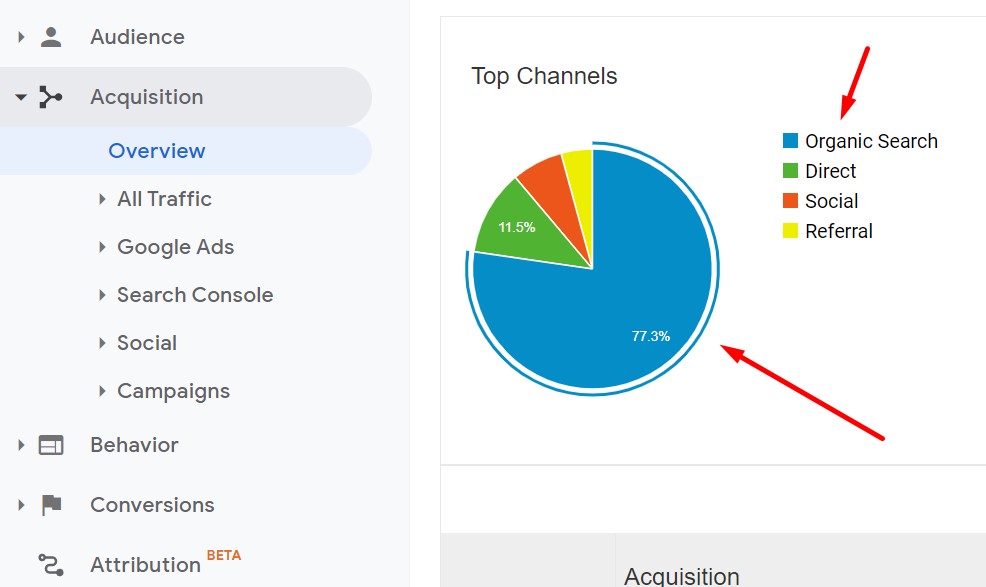
Organic traffic metrics provide an estimate of the monthly visitors arriving at your target website through unpaid search results.
Tools like Google Analytics, SEMrush, and SimilarWeb can be used to analyze this traffic and identify correlations with your backlink profile. This analysis allows you to assess the quality and quantity of visitors your backlinks generate for your content. Essentially, you can gauge how effectively your backlinks drive relevant traffic to your site.
To Wrap Up
So, you’ve put in the effort to build a solid backlink profile for your website. Great work! But the journey doesn’t end there. Tracking your link-building results is the next important thing you should consider as a website owner, SEO worker, or content creator. We hope that you’ve enjoyed learning about how you can assess a backlink by considering key link quality metrics.





